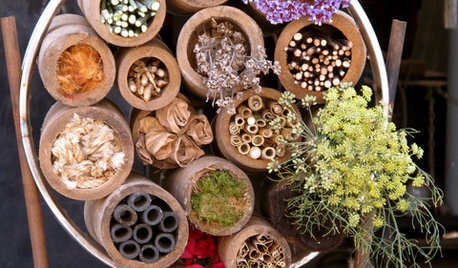is it natural or a pest?
rosebuddy
11 years ago
Related Stories

GARDENING GUIDESOrganic Matters: Thwart Insect Pests With Trap Crops
Add a few sacrificial plants to your garden to lure insects away from the harvest
Full Story
EDIBLE GARDENSNatural Ways to Get Rid of Weeds in Your Garden
Use these techniques to help prevent the spread of weeds and to learn about your soil
Full Story
URBAN GARDENSGardeners Champion Nature's Cause in the City
Garden advocates and artists in San Francisco have joined forces to find creative ways to bring nature back into the urban landscape
Full Story
GARDENING GUIDESTackle Weeds the Natural Way
Instead of dousing your yard with chemicals to wipe out weeds, let time and nature work their magic via smothering and solarization
Full Story
DECORATING GUIDESBring Nature Indoors With Tree Stumps, Trunks and Logs
Furniture formed from wood in its natural state adds earthy elegance to any room
Full Story
REMODELING GUIDESCork Flooring 101: Warm Up to a Natural Wonder
Comfortable, sustainable and easy on the eye, cork has a lot going for it. Use our guide to get familiar with this natural flooring material
Full Story
PLANTING IDEASWant a More Colorful, Natural Garden? Try a Perennial Meadow
Spend less time tending and more time taking in the sights by improving on Victorian and prairie garden designs
Full Story
GARDENING GUIDES5 Ways to Naturally Win the Weed War
Show irksome weeds no mercy with these tricks for combating them sans chemicals
Full Story
DESIGN DICTIONARYChinking
Without chinking to fill the spaces between timbers, log cabins would be draftier and filled with pests
Full Story
EDIBLE GARDENSGarden BFFs? Why Your Vegetables Are Begging for Companion Plants
Foster friendships among plants for protection from pests, pollination support and color camaraderie
Full StoryMore Discussions










greenlarry
Polly381
Related Professionals
Bridgetown Landscape Architects & Landscape Designers · Comstock Park Landscape Architects & Landscape Designers · Rancho Cordova Landscape Architects & Landscape Designers · Frisco Landscape Contractors · Arlington Landscape Contractors · Cornelius Landscape Contractors · Hilton Head Island Landscape Contractors · Kaneohe Landscape Contractors · Kaysville Landscape Contractors · Mastic Beach Landscape Contractors · New Cassel Landscape Contractors · Sugar Hill Landscape Contractors · The Woodlands Landscape Contractors · Tigard Landscape Contractors · Ogden Interior Designers & Decoratorstapla (mid-Michigan, USDA z5b-6a)
rhizo_1 (North AL) zone 7
rosebuddyOriginal Author
tapla (mid-Michigan, USDA z5b-6a)
rosebuddyOriginal Author
tapla (mid-Michigan, USDA z5b-6a)
greenlarry
rhizo_1 (North AL) zone 7
rosebuddyOriginal Author
rosebuddyOriginal Author
greenlarry
tapla (mid-Michigan, USDA z5b-6a)
greenlarry
rosebuddyOriginal Author
greenlarry
tapla (mid-Michigan, USDA z5b-6a)
flora_uk